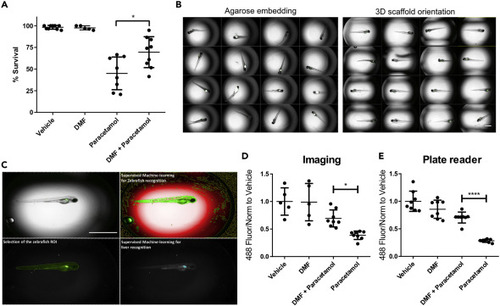Fig. 7
- ID
- ZDB-FIG-220107-26
- Publication
- Meseguer-Ripolles et al., 2021 - Dimethyl fumarate reduces hepatocyte senescence following paracetamol exposure
- Other Figures
- All Figure Page
- Back to All Figure Page
|
(A) WIK-larvae were treated with vehicle, and DMF (2.5uM) for 48 hr. The other experimental groups were treated with either vehicle or DMF (2.5uM) for 6 hr, prior to treatment with paracetamol (10mM) for a further 42 hr. Each dot represents the survival percentage of a biological replicate (30–35 zebrafish). Data ploteed as a dot plot with mean ± SEM. n=>5. One-way ANOVA test and post-hoc Tukey multiple-comparison test was used. ∗p < 0.05. (B) Methods for larvae orientation for live imaging. Plates that employ manual agarose embedding, demonstrate random distributions of larvae with focal variation. Plates prepared using the 3D scaffold orientation tool generates a reproducible system in terms of larvae position, focal plane, and spatial orientation. Scale bar represents 1 mm. (C) Supervised machine learning was used for automatic zebrafish recognition. Pixel texture was used to exclude background (red) from zebrafish (green) following refinement by size and shape. Selection of ROI based on shape and size of the larvae was used to distinguish between larvae and background. Next, supervised machine learning was used for GFP-positive liver recognition. Scale bar represents 1 mm. (D) Loss of GFP signal following 42 hr of paracetamol exposure was quantified using high content imaging. Wild-type lines were used to detect any potential issues with autofluorescence. n=>6. One-way ANOVA test and post-hoc Tukey multiple-comparison test was used. ∗p < 0.05. Data ploteed as a dot plot with mean ± SEM. (E) Loss of GFP signal following 42 hr of paracetamol exposure was measured using a plate reader. n=>3. One-way ANOVA test and post-hoc Tukey multiple-comparison test was used. ∗∗∗∗p < 0.0001. Data ploteed as a dot plot with mean ± SEM. |

